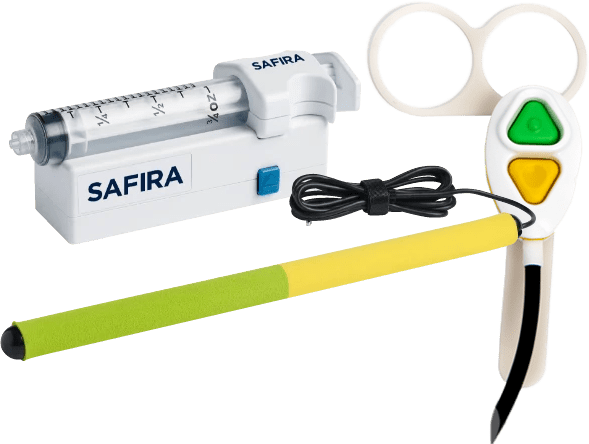Medovate Ltd, a medical device development company based in Cambridge, UK has signed a distributor agreement with 20/20 Imaging, a division of Konica Minolta Healthcare Americas Inc. to make its game-changing technology for regional anesthesia available across the veterinary market in the USA.
The SAFIRA® system – a revolutionary new technology that transforms regional anaesthesia into a one-person procedure – was originally developed for human patient use in hospitals, but huge potential for its unique benefits to be extended to veterinary regional anaesthesia has also been identified.
Medovate has worked with 20/20 Imaging to engage with veterinary professionals in the USA to gain insights and understanding around the potential for the SAFIRA® technology to revolutionise veterinary regional anesthesia practice.
Following positive feedback from the market, 20/20 Imaging are the first company to be appointed as a distributor for the SAFIRA® system in the veterinary market and they will now bring the unique patient and clinical benefits that the technology offers in human healthcare to veterinarians in the USA, focusing on small-animal regional anesthesia.
In current regional anesthesia procedures two operators are often needed, including a second operator (an assistant) who injects the anesthetic solution at the required pressure, which relies on ‘feel’. This means anesthetic solutions can be injected at high pressures which can increase risk of nerve injury.
SAFIRA® enables the veterinary practitioner to control the injection themselves, without the need for an assistant to control the syringe, and it also incorporates a pressure monitoring system which automatically stops injection at a calibrated threshold. Another benefit is that the system enables a controlled release of local anesthetic allowing lower amounts of local anesthetic to be injected.
Bob Salzman, President 20/20 Imaging said: “This is a ground-breaking new technology for safer regional anesthesia and is unique in making it a one person procedure and reducing reliance on subjective ‘injection pressure feel’. 20/20 Imaging are proud to be the first appointed distributor to be bringing its unique benefits to the veterinary market and we look forward to making this exciting technology available to veterinary professionals across America alongside our leading range of ultrasound solutions to enable them to deliver the best care for their patients.”
Regional anesthesia is an important part of small animal care and is used for many reasons in veterinary medicine, including improved quality of recovery. The use of ultrasound guided regional anesthesia is becoming more common practice today, with the technique – which can help provide a higher level of visualisation for the practitioner – increasingly seen as a ‘gold standard’.
There are limitations and challenges that are not always present in the practice of adult human medicine. Nerve injury for instance, is harder to ascertain in animals. Small animals such as cats also have increased sensitivity to local anesthetics when compared with other species, necessitating much lower maximum doses be used.[1]
Stuart Thomson, Managing Director at Medovate said: “With a significant number of regional anesthesia blocks completed in veterinary practice per year around the world, SAFIRA® can play a significant role in the future of veterinary regional anesthesia practice. We are delighted to be partnering with 20/20 Imaging as our new distributor partner for SAFIRA® in the veterinary market in the United States of America and we look forward to working with them roll out this exciting technology to US-based veterinary professionals. It is a very exciting time for our company as we launch our SAFIRA product portfolio into the US veterinary field.”
Developed in collaboration with consultant anesthesiologists in the UK National Health Service (NHS), SAFIRA® has been successfully launched in the human healthcare field in the USA, UK and Europe, Australia and New Zealand, Singapore and the Middle East.
Medovate has also partnered with Konica Minolta Healthcare Americas, Inc. in the human healthcare field to promote best practice within regional anesthesia across the United States and the Middle East. The partnership highlights the provision of Ultrasound Guided Regional Anesthesia and how the revolutionary SAFIRA® device can be used in conjunction with Konica Minolta Healthcare Americas’ Inc. range of pioneering ultrasound solutions such as the SONIMAGE® HS2 Portable Ultrasound System and the SONIMAGE® MX1 Platinum Compact Ultrasound System.
[1] Regional Anesthesia and Pain Management in Veterinary Medicine (asra.com)

